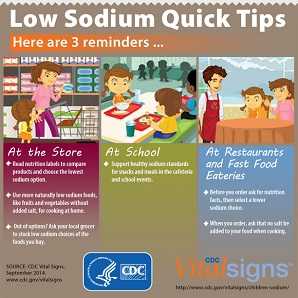Most Americans Should Consume Less Sodium
Most of the sodium we consume is in the form of salt, and the vast majority of sodium we consume is in processed and restaurant foods. Your body needs a small amount of sodium to work properly, but too much sodium is bad for your health. Excess sodium can increase your blood pressure and your risk for a heart disease and stroke. Together, heart disease and stroke kill more Americans each year than any other cause.1
Reducing Sodium in Children’s Diets
Nearly 9 in 10 US children eat more sodium than recommended, and about 1 in 9 children has raised blood pressure, which is a major risk factor for heart disease and stroke. Lowering sodium in children’s diets today can help prevent heart disease tomorrow. Small changes make a big impact on your child’s daily sodium intake [PDF-232K].
Sources of Sodium
Americans get 71% of their daily sodium from processed and restaurant foods.2 What is processed food?
Sodium is already in processed and restaurant foods when you purchase them, which makes it difficult to reduce daily sodium intake on your own. Although it is wise to limit your use of added table salt while cooking and at the table, only a small amount of the sodium we consume each day comes from the salt shaker.
CDC’s Sodium Reduction Initiative
CDC is working at the national, state, and local levels to help reduce sodium in the food supply. CDC’s approach to sodium reduction includes supporting and evaluating ongoing initiatives to reduce sodium, providing technical assistance to the public health community, expanding the scientific literature related to sodium reduction, collaborating with stakeholders, and educating the public. More information may be found here: CDC’s Sodium Reduction Initiative [PDF-338K].
Balancing Act: Sodium and Potassium
Did you know that sodium and potassium both affect blood pressure? In general, people who reduce sodium, who increase potassium, or who do both benefit from having lower blood pressure and reducing their risk for other serious health problems. Eating enough potassium each day can help balance out some of the harmful effects that high sodium intake can have on blood pressure. But lowering sodium intake is key to this balance.
Dietary Guidelines for Sodium
The 2015-2020 Dietary Guidelines for Americans recommend that Americans consume less than 2,300 milligrams (mg) of sodium per day as part of a healthy eating pattern.
Nearly everyone benefits from lower sodium intake. Learn more about who benefits in a recent CDC report.
Sodium Reduction Targets
The U.S. Food and Drug Administration (FDA) has released draft, voluntary sodium reduction targets for processed and prepared foods. This new guidance lays out achievable short-term and long-term goals for sodium reduction in about 150 categories of food. To learn more about sodium reduction, read the article in the Journal of the American Medical Association (JAMA). For more information about the science supporting sodium reduction and why accurate measurement matters, read the New England Journal of Medicine (NEJM) article.
Featured Items
From Menu to Mouth: Opportunities for Sodium Reduction in Restaurants
Americans eat out at fast food or dine in restaurants four or five times a week. Just one of those meals might contain more than an entire day’s recommended amount of sodium. In Preventing Chronic Disease Journal, a CDC report offers strategies for health departments and restaurants to work together to offer healthier choices for consumers who want to lower their sodium intake.
CDC’s Sodium Reduction in Communities Program (SRCP) in a Special Supplement
This issue of the Journal of Public Health Management and Practice highlights the methods, progress and lessons learned from the SRCP. The SRCP, launched by the CDC in 2010, works on the local level to increase the availability and access to lower sodium foods in settings like schools, work sites, grocery stores, restaurants, and congregant meal programs for older adults.
Sodium Intake in Populations: Assessment of the Evidence
The National Academy of Science issued their findings on “Sodium Intake in Populations: Assessment of the Evidence”. CDC commissioned this report to evaluate the results, study design and methodological approaches that have been used to assess the relationship between sodium and health outcomes.
Improving the Food Environment Through Nutrition Standards: A Guide for Government Procurement [PDF-653K]
This document provides practical guidance to states and localities for use when developing, adopting, implementing, and evaluating a food procurement policy.
References
- Kochanek KD, Xu JQ, Murphy SL, Miniño AM, Kung HC. Deaths: final data for 2009. Nat Vital Stat Rep. 2011;60(3).
- Mattes RD, Donnelly D. Relative contributions of dietary sodium sources. J Am Coll Nutr. 1991;10:383–93.
- Page last reviewed: August 18, 2017
- Page last updated: August 18, 2017
- Content source:



 ShareCompartir
ShareCompartir
